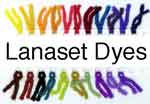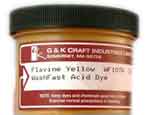What dyes can be used to dye hair (that is not on a person)?
—ADVERTISEMENTS—

(For silk, wool, angora, mohair & nylon)
Buy from
Paradise Fibers
Lanaset/Sabraset Dye for protein fibers such as silk, wool, angora, mohair, as well as nylon. All colors of Lanaset-Sabraset are permanent and inter-mixable. Excellent wash fastness and light fastness. 1 ounce of dye will dye 6 lbs. of fiber to a medium shade.
Washfast Acid dyes
at Paradise Fibers

Washfast Acid dyes
Designed to permanently dye protein fibers -- animal fibers like wool, silk, angora, mohair, alpaca and nylon. These brilliant shades are carefully selected from available super milling and premetalized colors. Substitute Ammonium Sulfate (for pastel to medium shades) or Citric Acid Crystals (for pastel to dark shades) for Acidic Acid 56% and obtain level dyeing results without the offensive odor. Apply at a boil for solid shade dyeing and steam set when printing, painting or rainbow dyeing. Two ounces of dye powder will color 12 pounds of wool to a medium shade in a solid shade dye bath.
Rit dyes are all-purpose dyes, which means that they are a mixture of acid dyes, for proteins such as wool and hair, with direct dyes, for cotton. The type of acid dyes used in all-purpose dye is called strong acid or acid leveling. This type of acid dyes is good for getting everything a perfectly smooth solid color, but wretched at washfastness, compared to some other types of acid dyes; that is, they bleed more when wet. Also, they require more acid than the other dyes do. The milder acid requirements of other types of acid dyes are probably better for the hair. They still require a low pH, but not as low of a pH.
The acid dyes that are best for hand-dyeing protein fibers black are 1:2 metal complex dyes, also known as premetallized acid dyes. One brand is Lanaset, which is expensive but generally agreed to include the best black dye available for hand dyeing, the Lanaset Jet Black. Lanaset dyes can be purchased from several sources, including PRO Chemical & Dye, and Paradise Fibers.
A less expensive but still excellent black dye is the Washfast Acid Jet Black. It, too, is available from both PRO Chemical & Dye and Paradise Fibers. It will be far more wash-resistant and non-bleeding than any Rit dye. Both it and the Lanaset dyes will resist bleeding even when the item dyed with it is washed at 140°F, unlike Rit dyes which should not be washed at temperatures above 105°F.
All acid dyes, including Rit dye, will work best if they are set with moist heat. This can be obtained by dissolving the dye in hot water and immersing the fiber (in your case hair) in the dyebath at the recommended temperature, or by painting the wet dye on the fiber and then wrapping it up and steaming it. Typically, Rit dye should be used at a temperature of 185°F for sensitive fibers, such as silk. Using it at lower temperatures will result in less bonding of the dye to the fiber. You should include an acid, such as vinegar, when dyeing any protein fiber, such as hair or wool. The makers of Tintex all-purpose dye, which like all dyes labeled all-purpose, contains some acid dye, recommend adding 100 ml (7 tablespoons) of distilled white vinegar per gallon of water in the dyebath. For other dyes, use whatever form of acid is recommended in the recipes provided by the manufacturer; closely following their well-tested recipes will give you the best results.
Another option would be to make your all-purpose Rit dye more washfast by using a cationic aftertreatment, such as Retayne, which you can buy by mail-order. See "Commercial Dye Fixatives". In general I think it's better to use a more permanent dye, instead of using an aftertreatment, because the extra step is a bother, and these cationic dye fixatives tend to reduce the resistance of a dye to being faded by light. It is a real option, however, one which you might want to consider.
(Please help support this web site. Thank you.)
Posted: Monday - February 23, 2009 at 09:30 PM
Follow this blog on twitter here.
- Top of this blog -
- FAQ -
- The Dye Forum -
- How to Tie Dye - How to Batik -
- Books - Toys - Plants -
More in this category:
- -
Total entries in this category:
Published On: Aug 29, 2012 02:48 PM